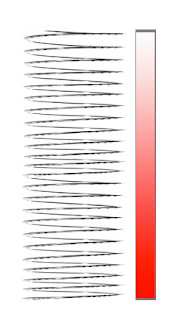If there is interior work to be done, it makes sense to make sure that prior to such work, the exterior keeps the elements outside. Thus the leak detected in the spring and ignored all summer needed attention.
 |
| Vacuuming the pine needles out of the seams between metal roof segments. Later, a few flicks with the screwdriver proved adequate. |
 |
| A few long roofing screws and the impact driver did the rest. Moisture is no longer expected to be forced beyond the seams by the wind. |
Shortly after this photo was taken, Pete-from-next-door offered both a safety suggestion and the rope to carry it out. A safety harness was formed by a loop around the waist. Then the opposite end of the rope was thrown over the peak and secured to Peter's earth mover, insuring that a missed step did not result in a long fall off the slippery green metal.
Then all well-grounded folks came around to the business side, in anticipation of possible macabre entertainment that did not come to pass.
 |
| Later that Friday evening, Booboo awards Chowdahead the hat he's been wanting for so long. Note the appropriate shirt. |
 |
| Wind driven rain and sleet made the next day quite memorable, but nearly impossible for outside work. |
 |
| A little bonus hail on the deck. The gang was all there, but not being paid enough to work outside in that stuff. |
 |
| Nonetheless, a few logs were made ready for splitting. |
 |
| In the garage, Cut Boy and Sam Adams made good progress despite being harassed by Chowdahead. |
 |
| Careful not to create relapse conditions necessitating additional back surgery, Dock Doc excelled at supervision. |
The Loonatics came to the unanimous conclusion that young blood is necessary. Two heart issues, one recovering from back surgery, another with no prostate, and a fifth struggling with hearing problems and probably dementia. When asked what his malady was, Chowdahead answered, "Baldness."
"But that's half the crew."
"Chronic flatulence?"
"That's at least the other half."
 |
| What's he pointing out? |
 |
| Even inclement weather could not prevent proper grooming. |
 |
| The little blue car snuggled up due to the weather. |
 |
| A man perhaps overly happy with his work. Were we wrong to give him the title of Hellfire? |
 |
| The previous shot is uncomfortably reminiscent of this Arnold Newman portrait of Alfried Krupp, don't you think? |
 |
| Regardless, the work goes on! |
 |
| Be sure that children can never access power tools. |
 |
| Always observe proper safety procedures. |
 |
| And be sure never to use a ladder on a stairway. |
 |
| But it is just fine to use ladders to escape from mice. |
 |
| Perseverance Pays! Naughty pine is behaving! |
 |
| Meanwhile, an experiment in acoustics is conducted. As Thomas Edison once said, "Now I know what not to do!" |
 |
| And in a final tribute to perseverance, a couple face cords in place for the winter. The birch is wet and the maple is punky, so the average should be just right! |
The last stick was stacked, and much of the crew on the road, so cleanup ensued. Chowdahead pilots a mean vacuum. Who knew?
A courtesy call on Pete at his house to thank him for the support and use of his machines was in order. While informing him where the splitter rested under a tarp, Pete decided that he absolutely had to come over and grab some prints of drone shots of the lake.
In he bustled with muddy boots, not only to grab the pictures, but to use the facilities as well. Territory marked, he was soon headed back home. Considering all the help he provided through the weekend, a heavy sigh was all that preceded the second cleanup.
The exit plans disrupted, the realization that a few things had been forgotten did not occur until near Utica. The hope is that the Friday-night chowder will stay contained, even if it comes to life in the fridge.














